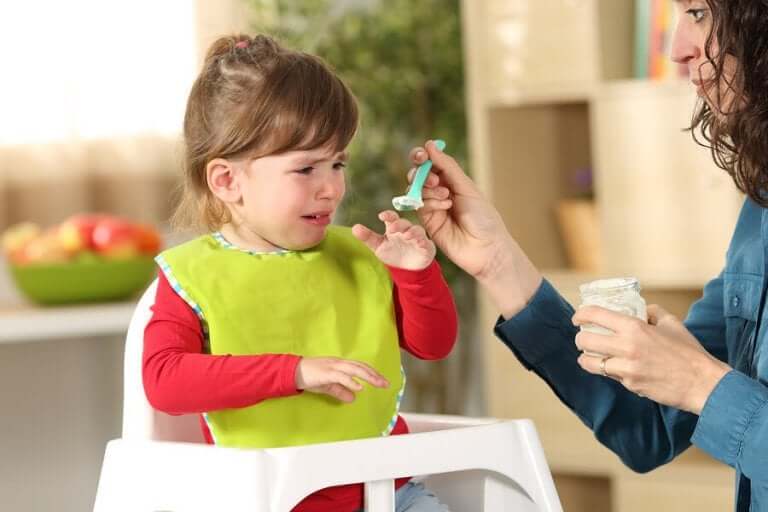Selective Eating Disorder in Infancy

It’s common for children to have certain eating difficulties. These are mainly preferences for certain foods, and a reluctance to eat others. However, in some cases, the rejection of food becomes so widespread that the person limits their intake to a very small group of foods. As a result, they won’t be providing for their own nutritional needs. When this happens, it’s known as selective eating disorder (SED).
This condition has never been diagnosed as a disorder until recently. However, in the last revision of the Diagnostic and Statistical Manual of Mental Disorders (DSM-V), it did achieve recognition as a disorder with well-defined characteristics. We now know that the tendency to avoid large food groups goes beyond a whim or childhood misconduct.
Selective eating disorder
Selective eating disorder is where a person has a limited and not very varied diet, and in which they refuse to try new foods. This refusal is based on the sensory characteristics of food (its texture, color, and shape). As a result, there are serious nutritional implications.

When children suffer from this disorder, it’s common for them to experience weight loss, or to not put on sufficient weight as they grow. In the same way, there’ll be a serious nutritional deficiency because, on many occasions, large food groups such as vegetables, fish or legumes are rejected.
The psychosocial plane is also affected, since the person will tend to avoid meetings in which their syndrome may come to light or pose some sort of problem. It’s a condition that affects the well-being of both the child who suffers and his or her primary caregivers. The child’s constant refusal to eat can become quite overwhelming and troubling.
More than a whim
We must never lose sight of the fact that this situation isn’t a reflection of a childish whim or a “spoiled” child. It’s a syndrome which can be caused by many factors, and which has deeper implications. Although experts don’t yet know the full reasons or causes, they’ve made the following findings:
- It’s common for these children to have an anxious personality, with obsessive-compulsive traits or a tendency towards social phobia. They also show a low adaptation to change and novelty. The disorder may develop from their rigid and inflexible personality.
- Researchers have observed problems in the link between the child and the primary caregiver. Children, unable to express themselves verbally, use screams or tantrums to communicate their dislike. This type of behavior can cause great stress, discomfort, and nervousness in the caregiver.
- This, in turn, will prevent the creation of a healthy bond of love and trust between them. To avoid these situations, the caregiver generally chooses to offer the child the least problematic foods, and this simply reinforces the child’s eating condition.
Several studies have found that a significant percentage of children and young people with this disorder have a fear of choking or vomiting, as well as certain food allergies.

How to prevent and treat selective eating disorder?
- When the baby begins to eat solids, methods such as baby-led weaning (BLW) can help them to explore the diversity of food and experiment with them at their own pace. In this way, the little one experiences mealtimes as a natural and fun process and not as an imposition.
- We must be constant and patient when offering varied foods, and mustn’t lose our nerve or give in to the child’s rejection.
- We are our children’s role model. It’s important for them to see that all family members eat what’s on the table, without exception. Meeting to eat and chat freely is also beneficial.
- We should try to be innovative in the kitchen, including the use of different textures, flavors and preparation methods. Doing something different with food will stimulate children’s curiosity and encourage them to taste and try new flavors.
- Once the disorder has been diagnosed, it’s important to seek professional help. In some cases, nutritional deficits may necessitate a short-term hospital stay.
- In any case, it’ll be necessary to intervene in an interdisciplinary way, with psychologists, doctors and nutritionists. They’ll need to work on the child’s stubborn personality and on the bond with the caregiver. And, above all, you’ll need to keep introducing new food into the child’s diet.
It’s common for children to have certain eating difficulties. These are mainly preferences for certain foods, and a reluctance to eat others. However, in some cases, the rejection of food becomes so widespread that the person limits their intake to a very small group of foods. As a result, they won’t be providing for their own nutritional needs. When this happens, it’s known as selective eating disorder (SED).
This condition has never been diagnosed as a disorder until recently. However, in the last revision of the Diagnostic and Statistical Manual of Mental Disorders (DSM-V), it did achieve recognition as a disorder with well-defined characteristics. We now know that the tendency to avoid large food groups goes beyond a whim or childhood misconduct.
Selective eating disorder
Selective eating disorder is where a person has a limited and not very varied diet, and in which they refuse to try new foods. This refusal is based on the sensory characteristics of food (its texture, color, and shape). As a result, there are serious nutritional implications.

When children suffer from this disorder, it’s common for them to experience weight loss, or to not put on sufficient weight as they grow. In the same way, there’ll be a serious nutritional deficiency because, on many occasions, large food groups such as vegetables, fish or legumes are rejected.
The psychosocial plane is also affected, since the person will tend to avoid meetings in which their syndrome may come to light or pose some sort of problem. It’s a condition that affects the well-being of both the child who suffers and his or her primary caregivers. The child’s constant refusal to eat can become quite overwhelming and troubling.
More than a whim
We must never lose sight of the fact that this situation isn’t a reflection of a childish whim or a “spoiled” child. It’s a syndrome which can be caused by many factors, and which has deeper implications. Although experts don’t yet know the full reasons or causes, they’ve made the following findings:
- It’s common for these children to have an anxious personality, with obsessive-compulsive traits or a tendency towards social phobia. They also show a low adaptation to change and novelty. The disorder may develop from their rigid and inflexible personality.
- Researchers have observed problems in the link between the child and the primary caregiver. Children, unable to express themselves verbally, use screams or tantrums to communicate their dislike. This type of behavior can cause great stress, discomfort, and nervousness in the caregiver.
- This, in turn, will prevent the creation of a healthy bond of love and trust between them. To avoid these situations, the caregiver generally chooses to offer the child the least problematic foods, and this simply reinforces the child’s eating condition.
Several studies have found that a significant percentage of children and young people with this disorder have a fear of choking or vomiting, as well as certain food allergies.

How to prevent and treat selective eating disorder?
- When the baby begins to eat solids, methods such as baby-led weaning (BLW) can help them to explore the diversity of food and experiment with them at their own pace. In this way, the little one experiences mealtimes as a natural and fun process and not as an imposition.
- We must be constant and patient when offering varied foods, and mustn’t lose our nerve or give in to the child’s rejection.
- We are our children’s role model. It’s important for them to see that all family members eat what’s on the table, without exception. Meeting to eat and chat freely is also beneficial.
- We should try to be innovative in the kitchen, including the use of different textures, flavors and preparation methods. Doing something different with food will stimulate children’s curiosity and encourage them to taste and try new flavors.
- Once the disorder has been diagnosed, it’s important to seek professional help. In some cases, nutritional deficits may necessitate a short-term hospital stay.
- In any case, it’ll be necessary to intervene in an interdisciplinary way, with psychologists, doctors and nutritionists. They’ll need to work on the child’s stubborn personality and on the bond with the caregiver. And, above all, you’ll need to keep introducing new food into the child’s diet.
All cited sources were thoroughly reviewed by our team to ensure their quality, reliability, currency, and validity. The bibliography of this article was considered reliable and of academic or scientific accuracy.
- Fisher, M. M., Rosen, D. S., Ornstein, R. M., Mammel, K. A., Katzman, D. K., Rome, E. S., … & Walsh, B. T. (2014). Characteristics of avoidant/restrictive food intake disorder in children and adolescents: a “new disorder” in DSM-5. Journal of Adolescent Health, 55(1), 49-52.
- Rodríguez, A. (2018, 29 julio). Ansiedad infantil: síntomas y tratamiento. Recuperado 24 octubre, 2019, de https://lamenteesmaravillosa.com/ansiedad-infantil-sintomas-y-tratamiento/
This text is provided for informational purposes only and does not replace consultation with a professional. If in doubt, consult your specialist.








